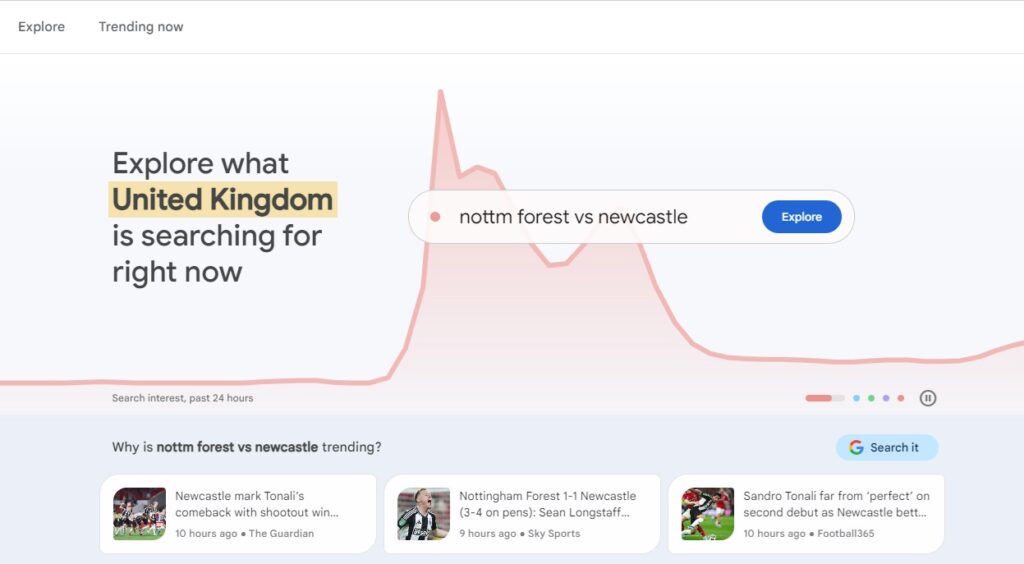The Top Trending Inventory-Free Products to Sell Online 2024
The UK online marketplace continues to boom — there’s no time like now to start your own online business. But with so many different ways to sell, it can get a bit overwhelming. For most startup e-tailers, the biggest challenge will be finding the space to store the goods on offer. Where to begin?
Luckily, there’s a smart way around that: going stock free. Yep – you can kick off a successful an online venture without turning your home into a warehouse. No faffing about with inventory management means you’re free to focus on doing what you do best — delivering fantastic service to your customers, building loyalty, and (fingers crossed) raking in a tidy profit.
In this article, we’ll have a look at ways to suss out hot, trending products to sell with no or low inventory.

Inventory-free online stores
How to start an inventory-free online store
Launching an online business, it goes without saying, is almost always easier and more affordable than setting up a physical shop. User-friendly platforms like Website Builder and Managed WordPress make getting a professional website online a breeze. It’s a doddle to find and buy a great domain name, too.
Alternatively (or at the same time) you can sell on the established marketplaces like Amazon, Etsy, eBay, or even Facebook Marketplace. Competition is fierce, but each offers insights into top trending products on that platform, helping you tap into current market demands. With trending data (and a bit of intuition) you’ll be able to stay ahead of the curve and find the items most likely to find buyers.
Choose a low or no inventory business model
The great thing about e-commerce is that you can start a business without shelling out for hefty rent and utilities. Grow at your own pace while getting the hang of things — no stressing over storage constraints.
There are various low-or-no inventory models to choose from. Each has its own pros and cons. Picking the right one will come down to your interests, talents, and resources. You don’t need to be a market guru or web dev to find success.
Here’s a breakdown of the main options:
Dropshipping: The classic stock-free model. In dropshipping, you’re a storefront without the inventory: you list your products for sale, and when a customer makes an order, then forward that to a supplier, who ships the product direct to the customer. The supplier manages storage, packing, and shipping entirely.
Fulfillment: A fulfillment centre is a facility that stores, packs, and ships products on your behalf. Unlike dropshipping, you’ll essentially buy the stock upfront and have it kept at the fulfillment centre for storage for you. As orders come in, they handle packing and shipping. Amazon’s Fulfillment by Amazon (FBA) is a well-known example, but there are lots out there.
Of course, both dropshipping and fulfillment come with lower profit margins due to the fees charged by suppliers. Fees are generally higher when dropshipping, as the supplier carries the inventory risk, and they’d be stuck with any unsold products.
Handmade: Crafting unique, handmade items with care and attention to detail – putting quality over quantity, and perhaps even telling a story about an items creation or origin. This is what handmade selling is about. There’s crossover with the next category…
Custom Made-to-Order: Creating unique products based on customer specifications. That might include handmade, as above, or perhaps items like bespoke furniture, jewellery, gifts, you name it. This all takes skill and craftsmanship, but the rewards can be sweet both when it comes to customer loyalty and profit.
Low-Inventory Reselling: Unlike traditional retail with huge amounts of inventory, the aim of a low-inventory reseller is to keep minimal stock through selective, high-demand products. Success will depend on identifying profitable deals and staying on top of market trends.
Used Items: While not entirely stock-free, selling used items can be done with a small, rotating inventory rather than large quantities.
Private Label: Going ‘Private label’ is all about rebranding products that have been manufactured by others. You’re putting your stamp on someone else’s work: customising goods with your own branding, packaging, labels. One example might be purchasing shampoo or perfume from a manufacturer, repackaging it (legally and with permission from the manufacturer!) for a healthy profit.
Subscription Services: Think of subscription services as a monthly treat box delivered to a doorstep. Customers pay a recurring fee to receive regular products or services. This steady income stream can be really profitable for entrepreneurs who can offer value and great customer service.
Digital Products: If you can share your knowledge or creativity with the world, digital products are your ticket. From e-books and online courses to software and artwork, there’s digital products for all. Storage shouldn’t be an issue, as your space is limited to hard disks, the cloud, or perhaps a Virtual Private Server (VPS).
See also: How to Start an Online Business (Without Any Money)
Top Trending Products to Sell Online
Tech Essentials
Tech essentials have become integral to modern lifestyles — devices made for our convenience and connectivity. The UK market for phone accessories alone is worth around £5.27 billion in 2023 and is expected to grow to £7 billion by 2030, with an annual increase of 3.6%.
For a business model with low or no stock, offering personalised and made-to-order tech essentials is one way to stand out. Think phone cases, mouse mats, custom laptop sleeves, personalised headphones, and even bespoke laptop stands.

Beauty and Wellness
Beauty and wellness products are always in high demand. The UK beauty and wellness industry estimated to be worth £39.04 billion and expected to keep growing 2% or so each year. As a dropshipping/fulfillment option, evergreen products include moisturisers and serums, shampoos and styling products, foundations and lipsticks. Social media platforms like TikTok are great for spotting (or even starting) the latest beauty trends.

Home and Living
Homeware and kitchen products are ideal for side hustlers looking to tap into a practical and stylish niche. Items like stylish kitchenware, including dish sets, utensils, and premium cookware, appeal to consumers looking to upgrade their homes. Popular home essentials might include soft furnishings, throws, and table linens. You might expand your range with accessories like storage solutions to space-saving kitchen gadgets.

Eco and Sustainable Choices
Promote eco-friendly living by offering reusable bags, bamboo products, and organic skincare. Help customers reduce their environmental impact while enjoying sustainable alternatives. According to one study, the sustainable fashion market is expected to grow at a compound annual growth rate (CAGR) of 7.3% from 2023 to 2030. That just goes to show the growing trend for more ethical and sustainable clothing choices.

Pet supplies
For pet owners, offer a variety of food, toys, and accessories to keep furry friends happy and entertained. The UK pet supplies market is buzzing, with a hefty value of around £3.5 billion in 2023. It’s been steadily growing at about 5% each year, thanks partly to the craze for premium and organic pet foods, along with fancy new pet health products. With Brits obviously happy to splurge on quality and unique pet goodies, the market is set to keep on growing. Grrr.

Personalised items
Customers like things that are personal and meaningful. Personalised items have always been a favourite for talented side hustlers and small online business owners. Think t-shirts, mugs, jewellery, or custom art. These sorts of goods have the potential to be low-or-no stock options when they’re lovingly made to order just for one individual, couple, or family.

DIY
Already a firm favourite for us Brits and still a growing sector, the DIY industry is expected to be worth around £568 million by 2028-29. Inspire creativity and self-expression in the home with a range of artistic and DIY products — think premium paints, tools, power drills, home renovation supplies, Laurence Llewelyn-Bowen wigs, that sort of thing.

Creative
More Brits are turning to arts and crafts as a way to relax, express themselves, and connect with others. Shows like The Great British Sewing Bee and The Great Pottery Throw Down have driven these trends, making sewing machines, fabrics, pottery wheels, and clay kits popular among hobbyists. Other drop-shippable items might include premium paints and pencils for aspiring artists, craft kits, and supplies for home decor enthusiasts.

Games and Gadgets
Gaming is no longer just for kids—people of all ages and backgrounds are getting in on the action. As of 2023, the UK video games industry is valued at a whopping £7.8 billion, marking a 4.4% rise from 2022. To put it in perspective, that’s significantly more than the UK music industry, worth £5.2 billion.
While there’s a lot of competition when it comes to consoles, think about selling essential gaming gear like controllers, headsets, and gaming chairs. For a profitable side hustle, you might also look into peripherals like mouse pads, gaming desks, and RGB lighting accessories. Add-ons that enhance the gaming experience and are always in demand among geeks (err, I mean “enthusiasts”) looking for an upgrade to their rig.

How to choose items to sell online
Unique and innovative: The key to success is items that stand out from the crowd. Look for goods with distinctive features that can’t be found on the average British high street, Products with a touch of eccentricity, will resonate with customers seeking something truly special.
Problem-solving: Solving problems is a winning formula. Look for products that address specific needs. As one rather famous tech entrepreneur once said, “You’ve got to start with the customer experience and work back toward the technology – not the other way around.”
Lovable: Not every product needs to be a problem-solver. Sometimes, girls (and boys) just want to have fun. Novelty products might evoke joy, nostalgia, or a playful eccentricity that resonates with customers.
Social media buzz: Pay attention to items that are gaining attention and shares on platforms like TikTok, Instagram, or X. Influencer endorsements can also boost a product’s popularity. With a finger on the pulse, you might even be able to pick out items before they go viral.
Customer reviews: Another big indicator – choose products with high ratings and positive feedback from satisfied customers. Perhaps even more importantly: steer clear of items that have been slated with 1 and 2 star reviews!
Search Engine Value: Search engine data can reveal insights into the hottest products. Products that match popular words will also be easier for potential customers to find. As we’ll get into, tools like Google Trends are out there to show what’s popular right now.
Value for money: Choose products that offer good value for the price. This is especially true when selling smaller items in larger quantities. But while affordability is important, pricing strategies can vary: for premium or unique products, higher prices bring greater profit margins. Which brings us to…
A strong markup: Choose products with a healthy markup. Think about the cost of goods, overhead expenses, and your desired margin. Profit is the aim of the game, after all.
How to get stats on trending products
There are lots of different resources out there to help you spot hot products and up-and-coming fashions and buying habits.
Google Trends is a fantastic tool for getting a handle on search interests over time. If you’re a side hustler or running a small online store, especially on a drop shipping model, Trends can be seriously useful. You can explore search terms related to your product categories or target market to uncover potential opportunities for increasing your online sales. It helps you spot emerging trends and make informed decisions, all without any need for extensive inventory management.

E-commerce platforms like Amazon Seller Central and eBay Seller Hub also offer insights into best-selling items (plus their own sales data) and that can all give you a sense of what UK buyers are currently interested in. For more, publications like Retail Insider and Internet Retailer offer excellent insights, and for a more UK-specific view, check out Retail Gazette for news on e-commerce, store design, and shopping trends.
See also: How to Use Google Trends for Your Online Business
Wrap Up
And there you have it — a selection of trending and easy-to-sell products that don’t require you to keep inventory. Take the plunge and see where your entrepreneurial journey takes you.
Ready to turn your idea into a reality? 123 Reg’s Website Builder makes it easy to create a professional website and start selling your products online: choose a theme, customise your site, add your products, and start accepting payments. It’s everything you need to launch a professional website for your business — in just a few clicks!

